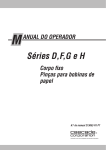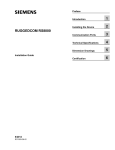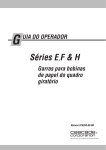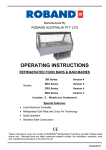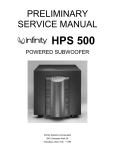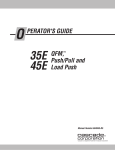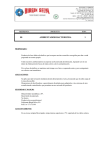Download Fixed Frame Paper Roll Clamp Operator Guide
Transcript
O PERATOR'S GUIDE D, F, G & H-Series Fixed Frame Paper Roll Clamps Manual Number 210135-R9 cascade corporation Cascade is a Registered Trademark of Cascade Corporation C ONTENTS Introduction Safety Rules Daily Inspection Clamp Operation Roll-Handling Basics Handling two rolls using split-arm clamp Upending Vertical Pickup, Transport, Unloading Bilge (Horizontal) Pickup, Transport Stacking, Unstacking Unloading Truck Trailers Breakout - Fixed Frame Clamp Boxcars Breakout - Fixed Frame Clamp Loading Truck Trailers Boxcars Tower Clamp Loading, Transport, Unloading, Stacking Loading with Adjustable Bumper Option Load Troubleshooting Safe Operation and Maintenance OHSA Regulations I 12 13 WARNING: Rated capacity of the truck/attachment combination is a responsibility of the original truck manufacturer and may be less than shown on the attachment nameplate. Consult the truck nameplate. WARNING: Do not operate this attachment unless you are a trained and authorized lift truck driver. CAUTION: This guide shows load handling procedures for most products. Ask your company or organization about any special procedures for the loads you may be handling. 14 15 16 18 18 19 NTRODUCTION Fixed Frame Paper Roll Clamp – Cascade Fixed Frame Paper Roll Clamps, Models D, F, G & H-Series are multiple-function attachments for handling all types of paper roll products. Clamps are designed for both bilge and vertical roll handling for transport, stacking, breakout, van trailer, boxcar and ship loading and unloading. Clamps can rotate through 360 degrees and can have a fixed short arm for full rolls or adjustable short arm for butt rolls, and a single or split long arm. Tower clamp versions provide bulk roll handling in many configurations. About this Guide – The information in this Guide is intended to simplify operator understanding about effective and safe Clamp use and operation. Read this guide thoroughly before operating the attachment. Be sure you know and understand all operating procedures and safety precautions. If you have any questions, or don’t understand a procedure, ask your supervisor. Emphasize Safety! Most accidents are caused by operator carelessness or misjudgment. You must watch for poorly maintained equipment and hazardous situations and correct them. 1 Page 1 2 4 5 6 7 8 9 10 11 Clamping Long Arm Hydraulic Cylinders Baseplate Contact Pads RC0025.eps Mounting Hooks Fixed or Adjustable Short Arm 210135-R9 S AFETY RULES Industrial Lift Trucks No reaching through mast No riders No standing under load RC0026.eps Tilt With load Raise 3 in. (8 cm) No load P P Traveling empty Motor off, park, lower load RAMPS P No parking on ramp No turning on ramp Watch clearances RC0027.eps TRAFFIC STOP Observe Wet floors 210135-R9 Workers Stops Bumps Dips Slow for two-way traffic Sound horn, slow at intersection Sound horn, slow at corner 2 S AFETY RULES Handling Loads: Rolls must be secure prior to lifting and transporting. Limit swinging clamp with raised load. LOAD WEIGHT Make sure load is centered and secure prior to lifting and traveling. Check for load slippage (see Load Troubleshooting). Load weight must not exceed combined truck/ attachment capacity (see truck nameplate). Use caution when handling unitized (wrapped) multiple stacked rolls with Single-Arm Clamp. Limit truck movement with raised load. RC0721.eps Split-Arm Clamp is recommended to handle two rolls (see Roll Handling Basics). Handling two rolls with Single-Arm Clamp may be dangerous and lead to serious injury. Make sure bottom roll is secure. Position the paper roll center of gravity as close as possible to the center of rotation to minimize lateral offset. Paper Roll Center of Gravity Center of Rotation RC3942.eps Lateral Offset 3 210135-R9 D AILY INSPECTION Check items each day. Report problems to your supervisor. Check clamp force prior to each operational shift. See Service Manual for troubleshooting, maintenance and repair procedures. Upper hook engagement Pad edges Fasteners RC0029.eps Safety decals & nameplate Cylinders and hoses for leaks 210135-R9 Lower hook engagement 4 C LAMP OPERATION AUXILIARY VALVE FUNCTIONS Hoist down WARNING: Truck control handle and attachment function activation shown here conforms to ASME/ANSI B56.1 recommended practices. Failure to follow these practices may lead to serious bodily injury or property damage. End user, dealer and OEMs should review any deviation from the practices for safe operation. Tilt forward A C B D GA0005.eps Hoist up Tilt back ROTATE LONG ARM (Vert. & horiz. positions only) C Release D Clamp (Driver's view) B A D C D SHORT ARM (45-degree position only) C Open D Close C RC0031.eps RC0030.eps B UPENDING TILT (Solenoid Equipped) A Rotate Counterclockwise A Tilt Forward (Press Button) B Rotate Clockwise B Tilt Backward (Press Button) UPENDING TILT (Non-Solenoid) A Tilt Forward B Tilt Backward A A Counterclockwise (CCW) B Clockwise (CW) RC3739.eps The following identification decal (located on the baseplate), shows how the split-arm roll clamp functions: 1 1 1 TYPE O 2 6096928-R1 OR TYPE 1 2 6093628-R1 RC4075.eps Clamp force is developed without the need for the top arm to fully close. 5 The top arm must fully close before clamp pressure is developed. 210135-R9 R OLL-HANDLING BASICS CLAMPING ROLL Center Clamp pads on roll Clamp through roll centerlines RC0033.eps RC0032.eps CARRYING ROLL Tilt RC0037.eps 3-4° 12 in. (30 cm) RC0036.eps Roll vertical, tilted back CLAMP FORCE Kraft Tissue RC0034.eps Pressure selection valve RC0035.eps Use proper clamping force for load being handled Also, see the following: • Clamp Force Indicator Operator Guide 214750 • Establishing Clamp Force TB 284 GA0072.eps 210135-R9 6 R OLL-HANDLING BASICS Handling two rolls using split-arm clamp Center Clamp pads between rolls CAUTION: Clamp multiple rolls securely and properly prior to lifting or traveling. WARNING: Engine speed MUST be increased when clamping or releasing rolls with Split-Arm Clamps. RC0038.eps Position the paper roll center of gravity as close as possible to the center of rotation to minimize lateral offset. This will reduce torque requirements and increase truck stability. Recommended roll width 2X pad height 'A' if rotating, 3X maximum A Paper Roll Center of Gravity Center of Rotation RC3942.eps RC0789.eps Lateral Offset A Maximum roll width 3X pad height 'A' if not rotating Position short arm on rolls before clamping RC1188.eps RC0039.eps 7 210135-R9 R OLL-HANDLING BASICS Upending Center clamp pads vertically on roll, if possible RC3763.eps RC3740.eps Clamp through roll centerline CAUTION: Verify the clearance between the bottom of the roll and mast prior to tilting the roll forward. Raise roll to clear ground when tilted RC3743.eps RC3741.eps Tilt roll forward CAUTION: Verify the center of gravity for the load does not exceed the capacity of the truck. Consult OEM as required. RC3742.eps Transporting CAUTION: Transporting in any position other than vertical is not acceptable unless attachment is specifically designed for that application. RC4141.eps Vertical transport position 210135-R9 8 V 1 ERTICAL PICKUP, TRANSPORT, UNLOADING 2 Position Clamp parallel to and centered on roll A)Adjust short arm for roll diameter B)Drive forward, touch short arm to roll RC2167.eps C)Clamp with long arm RC0041.eps 3 4 Raise, tilt back for transport 3-4° 2-4 in. (5-10 cm) Tilt vertical before lowering to floor 12 in. (30 cm) RC0043.eps 9 RC0044.eps 210135-R9 B 1 ILGE (HORIZONTAL) PICKUP 2 Tilt, lower Clamp to ground 3-4° Square truck to roll, position Clamp parallel to roll Short arm down RC0046.eps RC0045.eps 3 A) Drive forward, touch short arm to roll B) Clamp with long arm 4 A)Tilt, raise roll 3-4° 2-4 in. (5-10 cm) RC0047.eps RC0049.eps B)Rotate to vertical for transport Position the paper roll center of gravity as close as possible to the center of rotation to minimize lateral offset. This will reduce torque requirements and increase truck stability. Paper Roll Center of Gravity RC0048.eps Center of Rotation RC3942.eps Lateral Offset 210135-R9 10 S 1 TACKING, UNSTACKING 2 A)Drive slowly forward, touch short arm to roll A) Raise roll for clearance B) Tilt back for transport 12 in. (30 cm) RC2160.eps B)Clamp with long arm 3 3-4° 2-4 in. (5-10 cm) RC1010.eps 4 A) Slowly approach stack B) Tilt roll to vertical, raise for clearance 2-4 in. (5-10 cm) A) Square truck to stack, drive slowly forward, stop B) Set roll down squarely NOTE: Back tilt required if angled clamp mount used RC1020.eps 5 6 HIGH STACKING ABOVE TWO ROLLS: A) Square truck to stack, drive slowly forward, stop Roll Vertical B)Set roll down squarely CAUTION: 0 ° Clamp mount (shown) may be required above 130 in. (330 cm) – check Clamp model RC1059.eps 11 RC1009.eps PADS AT BOTTOM OF ROLL: A) Contact truck OEM to check truck stability B) Perform rotation drift test per Cascade TB258 Roll Vertical CAUTION: No rotation when clamped at bottom of roll NOTE: Back tilt required if angled clamp mount (shown) is used RC1021.eps 210135-R9 U 1 NLOADING TRUCK TRAILERS (BREAKOUT) Fixed-Frame Clamp Tilt, center Clamp to 1st roll 2 CAUTION: Trailer must be inspected for damage before unloading. Position arms to roll diameter, short arm toward wall Short Arm Dockplate required RC0055.eps CAUTION: Block trailer wheels 3 RC0054.eps RC0054.eps 4 Drive forward, angle truck to grip 1st roll behind centerline Clamp 1st roll, move back for clearance to re-clamp RC0056.eps RC0057.eps 5 6 Re-clamp through roll centerline with long arm, withdraw roll Raise, tilt back for transport 3-4° 12 in. (30 cm) RC0059.eps RC0058.eps 210135-R9 12 U 1 NLOADING BOXCARS (BREAKOUT) Fixed-Frame Clamp 2 Tilt, center Clamp to 1st roll Position arms to roll diameter RC0061.eps RC0060.eps 3 RC0060.eps Drive forward, angle truck to grip roll behind centerline 4 Clamp 1st roll, move back for clearance to re-clamp RC0062.eps Dockplate required 5 RC0063.eps Arms not wedged Re-clamp through roll centerline with long arm, withdraw roll RC0064.eps 6 Raise, tilt back for transport 3-4° 12 in. (30 cm) RC0059.eps 13 210135-R9 L 1 OADING TRUCK TRAILERS Rotate roll to position short arm toward wall CAUTION: Trailer must be inspected for damage before loading Dockplate required CAUTION: Block trailer wheels RC0065.eps 2 Drive down center of trailer, tilt vertical, brake slowly 12 in. (30 cm) RC0066.eps 3 4 A)Reposition truck to place rolls against wall Position rolls together / use spacers to prevent load shifting Short Arm B)Release long arm RC0067.eps 210135-R9 RC0068.eps 14 L OADING BOXCARS 1 B)Tilt to vertical A)Rotate roll to position short arm toward wall Dockplate required RC0069.eps 2 A) Reposition truck to place rolls against wall RC0070.eps B)Lower to floor, release long arm 3 Position arms to roll diameter, grip last rolls behind centerline RC0061.eps 4 Angle truck to place interior and last rolls RC0062.eps Arms not wedged 15 210135-R9 T OWER CLAMP Loading, Transport, Unloading, Stacking 1 A)Align truck with rolls B)Fully open arms 2 A)Approach rolls slowly B)Touch center pads to rolls RC2028.eps RC1870.eps (shown: powered center arms) 3 B)Adjust telescoping upper clamp arms to center on upper rolls A)Center lower clamp arms on lower rolls RC1866.eps 4 Clamp through roll centerlines RC1869.eps (shown: non-powered center arms) 210135-R9 16 T OWER CLAMP Loading, Transport, Unloading, Stacking 5 Lift load, proceed slowly CAUTION: Truck balance may be critical when turning with full loads 12 in. (30 cm) RC2038.eps 6 A)Check Clamp Pads are vertical Shut Off Unused Arms RC2556.eps No L-shaped loads 4 in. (10 cm) B)Check clearances – • Roll-to-roll • Truck-to-stack RC2029.eps RC1868.eps 17 210135-R9 L OADING WITH ADJUSTABLE BUMPER OPTION VERTICAL PICKUP BILGE PICKUP A)Close arms to approximate roll diameter A)Close arms to approximate roll diameter B)Drive forward touching bumper to roll 3-4° C)Clamp with long arm 2-4 in. (5-10 cm) RC2169.eps RC0074.eps C)Clamp with long arm L B) Tilt, drive forward touching bumper to roll OAD TROUBLESHOOTING IF LOAD IS SLIPPING: 1 Check weight of roll is within capacity range of Clamp (See nameplate) 3 D) When clamping with the long arm, allow the truck to move in neutral or with clutch disengaged. The bumper may have a tendency to move the truck forward or backward when adjusting to the roll size. Check hydraulic supply pressure and clamp force, see following: • Appropriate Clamp Service Manual • Clamp Force Indicator Operator Guide 214750 • Establish Clamp Force TB 284 4 2 Re-clamp load, contact pads centered on and parallel to roll, roll against bumper (if equipped) 210135-R9 Check condition and type of contact pad surface, change or replace if necessary RC2166.eps 18 S AFE OPERATION AND MAINTENANCE OSHA Regulations – Industrial Trucks and Attachments WARNING: The safe operation and maintenance of industrial trucks is regulated by Occupational Safety and Health (OSHA) regulations 1910.178 and Ameri- can National Standards Institute (ANSI) Safety Standard for Powered Industrial Trucks, ANSI B56.1. When operating and maintaining industrial trucks equipped with attachments you should pay particular attention to the following sections of these regulations. You should be familiar with all sections of these regulations. Ask your employer for the complete regulations. (a) General Requirement (4) Modifications and additions which affect capacity and safe operation shall not be performed by the customer or user without manufacturers prior written approval. Capacity, operation and maintenance instruction plates, tags or decals shall be changed accordingly. (5) If the truck is equipped with front-end attachments other than factory installed attachments, the user shall request that the truck be marked to identify the attachments and show the appropriate weight of the truck and attachment combination at maximum elevation with load laterally centered. (6) The user shall see that all nameplates and markings are in place and maintained in a legible condition. (e) Safety Guards (2) If the type of load presents a hazard, the user shall equip fork trucks with a vertical load backrest extension in accordance with (a)(2) following. (a)(2) All new powered industrial trucks acquired and used by an employer after February 15, 1972 shall meet the design and construction requirements for powered industrial trucks established in the “American National Standard for Powered Industrial Trucks, Part II, ANSI B56.1”, except for vehicles intended primarily for earth moving or over-the-road hauling. (10) A load backrest extension shall be used whenever necessary to minimize the possibility of the load or part of it from falling rearward. (n) Traveling (4) The driver shall be required to slow down and sound the horn at cross isles and other locations where vision is obstructed. If the load being carried obstructs forward view, the driver shall be required to travel with the load trailing. (7i) When ascending or descending grades in excess of 10 percent, loaded trucks shall be driven with the load upgrade. (7iii) On all grades the load and load engaging means shall be tilted back if applicable, and raised only as far as necessary to clear the road surface. (o) Loading (1) Only stable or safely arranged loads shall be handled. Caution shall be exercised when handling off-center loads which cannot be centered. (2) Only loads within the rated capacity of the truck shall be handled. (3) The long or high (including multiple-tiered) loads which may affect capacity shall be adjusted. (4) Trucks equipped with attachments shall be operated as partially loaded trucks when not handling a load. (5) A load engaging means shall be placed under the load as far as possible; the mast shall be carefully tilted backward to stabilize the load. (6) Extreme care shall be used when tilting the load forward or backward, particularly when high tiering. Tilting forward with load engaging means elevated shall be prohibited except to pick up a load. An elevated load shall not be tilted forward except when the load is in a deposit position over a rack or stack. When stacking or tiering, only enough backward tilt to stabilize the load shall be used. (l) Operator Training Only trained and authorized operators shall be permitted to operate a powered industrial truck. Methods shall be devised to train operators in the safe operation of powered industrial trucks. (p) Operation of the Truck (m) Truck Operations (1) Trucks shall not be driven up to anyone standing in front of a bench or other fixed object. (2) No person shall be allowed to stand or pass under the elevated portion of any truck, whether loaded or empty. (3) Unauthorized personnel shall not be permitted to ride on powered industrial trucks. A safe place to ride shall be provided where riding of trucks is authorized. (4) The employer shall prohibit arms or legs from being placed between the uprights of the mast or outside the running lines of the truck. (5iii) When the operator of an industrial truck is dismounted and within 25 feet of the truck still in his view, the load engaging means shall be fully lowered, controls neutralized and the brakes set to prevent movement. 19 (1) If at any time a powered industrial truck is found to be in need of repair, defective, or in any way unsafe, the truck shall be taken out of service until it has been restored to safe operating condition. (q) Maintenance of Industrial Trucks (1) Any power-operated industrial truck not in safe operating condition shall be removed from service. All repairs shall be made by authorized personnel. (5) All parts of any such industrial truck requiring replacement shall be replaced only by parts equivalent as to safety with those used in the original design. (6) Industrial trucks shall not be altered so that the relative positions of the various parts are different from what they were when originally received from the manufacturer, nor shall they be altered either by the addition of extra parts not provided by the manufacturer or by the elimination of any parts. Additional counter-weighting of fork trucks shall not be done unless approved by the truck manufacturer. (7) Industrial trucks shall be examined before being placed in service and shall not be placed in service if the examination shows any condition adversely affecting the safety of the vehicle. Such examinations shall be made at least daily. When industrial trucks are used on a round-the-clock basis, they shall be examined after each shift. Defects when found shall be immediately reported and corrected. (5i) When a powered industrial truck is left unattended, load engaging means shall be fully lowered, controls shall be neutralized, power shall be shut off and brakes set. Wheels shall be blocked if the truck is parked on an incline. (5ii) A powered industrial truck is unattended when the operator is 25 feet or more away from the vehicle which remains in his view, or whenever the operator leaves the vehicle and it is not in his view. (6) A safe distance shall be maintained from the edge of ramps or platforms while on any elevated dock or platform or freight car. Trucks shall not be used for opening or closing freight doors. 210135-R9 BLANK Do you have questions you need answered right now? Call your nearest Cascade Service Department. Visit us online at www.cascorp.com AMERICAS Cascade Corporation U.S. Headquarters 2201 NE 201st Fairview, OR 97024-9718 Tel: 800-CASCADE (227-2233) Fax: 888-329-8207 Cascade do Brasil Rua João Guerra, 134 Macuco, Santos - SP Brasil 11015-130 Tel: 55-13-2105-8800 Fax: 55-13-2105-8899 Cascade Canada Inc. 5570 Timberlea Blvd. Mississauga, Ontario Canada L4W-4M6 Tel: 905-629-7777 Fax: 905-629-7785 EUROPE-AFRICA Cascade Italia S.R.L. European Headquarters Via Dell’Artigianato 1 37050 Vago di Lavagno (VR) Italy Tel: 39-045-8989111 Fax: 39-045-8989160 Cascade (Africa) Pty. Ltd. PO Box 625, Isando 1600 60A Steel Road Sparton, Kempton Park South Africa Tel: 27-11-975-9240 Fax: 27-11-394-1147 ASIA-PACIFIC Cascade Japan Ltd. 2-23, 2-Chome, Kukuchi Nishimachi Amagasaki, Hyogo Japan, 661-0978 Tel: 81-6-6420-9771 Fax: 81-6-6420-9777 Cascade Korea 121B 9L Namdong Ind. Complex, 691-8 Gojan-Dong Namdong-Ku Inchon, Korea Tel: +82-32-821-2051 Fax: +82-32-821-2055 Cascade-Xiamen No. 668 Yangguang Rd. Xinyang Industrial Zone Haicang, Xiamen City Fujian Province P.R. China 361026 Tel: 86-592-651-2500 Fax: 86-592-651-2571 Cascade Australia Pty. Ltd. 1445 Ipswich Road Rocklea, QLD 4107 Australia Tel: 1-800-227-223 Fax: +61 7 3373-7333 Cascade New Zealand 15 Ra Ora Drive East Tamaki, Auckland New Zealand Tel: +64-9-273-9136 Fax: +64-9-273-9137 Sunstream Industries Pte. Ltd. 18 Tuas South Street 5 Singapore 637796 Tel: +65-6795-7555 Fax: +65-6863-1368 Cascade India Material Handling Private Limited No 34, Global Trade Centre 1/1 Rambaugh Colony Lal Bahadur Shastri Road, Navi Peth, Pune 411 030 (Maharashtra) India Phone: +91 020 2432 5490 Fax: +91 020 2433 0881 c © Cascade Corporation 2011 08-2011 Part Number 210135-R9






















